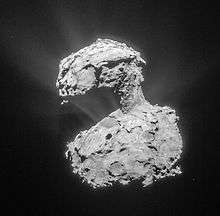Contact binary (small Solar System body)

67P/Churyumov–Gerasimenko, a suspected contact-binary comet, with two distinct lobes connected by a "neck", imaged by Rosetta
_Itokawa.jpg)
A diagram showing the average density of the two lobes of 25143 Itokawa, a suspected contact binary asteroid. The two lobes were likely originally separate bodies. The lobes are in reality connected.
A contact binary is a small Solar System body that is composed of two bodies that have gravitated toward each other until they touch. This means contact binaries have odd shapes. Comet Churyumov–Gerasimenko[1][2] and Comet Tuttle are most likely contact binaries. Asteroids suspected of being contact binaries include the unusually elongated 624 Hektor and the bilobated 216 Kleopatra and 4769 Castalia. 25143 Itokawa, which was photographed by the Hayabusa probe, also appears to be a contact binary which has resulted in an elongated, bent body. About 10–15% of near-Earth asteroids larger than 200 meters are expected to be contact binaries with two lobes in mutual contact.[3]
| Object | Dimensions (km) (approximate) | Rotation period (hours) |
|---|---|---|
| 2063 Bacchus | 2.6×1.1×1.1 | 14.9 |
| 4450 Pan | 1.0 | 60 |
| 4486 Mithra | 1.6 | 67.5 |
| 4769 Castalia | 0.6 | 4 |
| 11066 Sigurd | 3.0 | 8.5 |
| (179806) 2002 TD66 | 0.3 | 9.5 |
| 2007 TU24 | 0.3 | 36 |
| 8P/Tuttle | 4.5 | |
| 2014 HQ124 | 0.4 | 20+ |
See also
References
- ↑ Quick Rosetta update: Churyumov-Gerasimenko is a contact binary!
- ↑ Success! A final flawless burn. Rosetta now in tandem with its comet
- ↑ Michael Busch (2012-03-12). "Near-Earth Asteroids and Radar Speckle Tracking" (PDF). Retrieved 2014-02-28.
- ↑ Dr. Lance A. M. Benner (2013-11-18). "Binary and Ternary near-Earth Asteroids detected by radar". NASA/JPL Asteroid Radar Research. Retrieved 2014-03-01.
This article is issued from
Wikipedia.
The text is licensed under Creative Commons - Attribution - Sharealike.
Additional terms may apply for the media files.